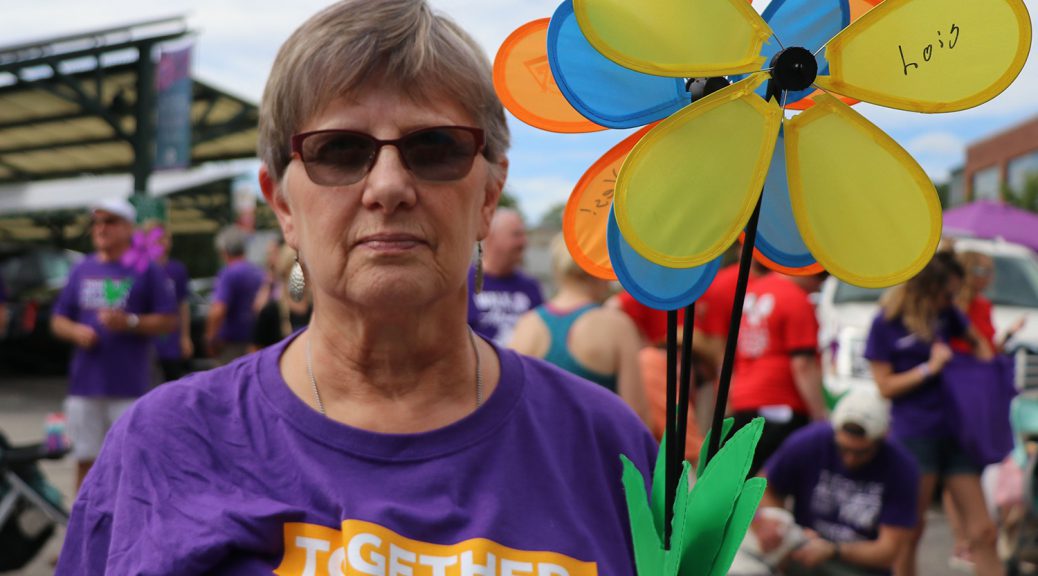
Bloomington Walks to End Alzheimer’s



A sizable crowd gathers at City Hall Plaza in downtown Bloomington on a sunny mid-September afternoon. Children play games, dogs scamper around excitedly, and volunteers hand out colorful flower-shaped pinwheels. Bright purple, blue, yellow, and orange pinwheels litter the plaza as a woman rallies the mass of people. It is the 2018 Bloomington Walk to End Alzheimer’s. This event occurs annually in more than six hundred communities nationwide, making it the world’s largest fundraising event for Alzheimer’s care, support, and research.
The 2018 Bloomington Walk attracted about seven hundred participants. One woman in particular stood out. She looked friendly, but her strength was apparent. Lois Sauder, four-time Walk participant, has dealt with Alzheimer’s for about twelve years. Diagnosed early when she was fifty-six and still living in Florida, she has since moved to Bloomington to be closer to family, participated in a double-blind study, and eventually found medication that has helped her manage the disease. Lois also attends a support group twice a month and leans on her family members from day to day.
John Sauder, Lois’ husband of forty-five years, took on the role of being Lois’ main caretaker once she was diagnosed. He said, “The biggest thing is accepting her as she is and being there when she feels discouraged.” John also disclosed that some days are better than others. The days in which Lois can’t remember who she is are particularly rough. For people living with Alzheimer’s, every basic emotion—loss, loneliness, sadness, confusion, anxiety, frustration, fear, anger—can be heightened to unimaginable levels, and each person’s experience with the disease is unique.
John and Lois’ son Virgil accompanied the couple to the Walk. He recalled that it was surreal when he found out about his mother’s diagnosis. Since she was diagnosed early, “[her symptoms of Alzheimer’s] weren’t obvious,” so it was a long, complicated process coming to terms with Lois’ condition.
Despite the hardship associated with Alzheimer’s, the family remains positive. “This event means everything to me. [Even] if there’s no hope for me, I’m at least here [to show support] for future generations,” Lois said. John agreed, saying that although it can be scary to imagine what the future holds, the Walk to End Alzheimer’s is exciting and empowering. Virgil added, “Each year, it gets bigger and bigger.”
Lois also emphatically praised the services that she receives here in Bloomington through the Greater Indiana Chapter of the Alzheimer’s Association. According to Natalie Sutton, the chapter executive, the organization seeks to “directly serve [their] clients by having social workers available, providing a 24/7 help line, and offering sixty-five support groups in Indiana.”
Sutton, who lost her grandfather to Alzheimer’s in December of 2017, commented on the toll the disease takes on all those affected. She also said, “Most families have a story or connection with this mission and this disease.” It’s true: Alzheimer’s is an epidemic; more than five million Americans currently live with the disease, and an American develops it every sixty-five seconds, according to the Alzheimer’s Association. Worse, it is the only cause of death in America in the top ten that cannot be prevented, slowed, or cured. Sutton added, “Hopefully, someday, we’re not in this situation we’re in right now, and people will be able to survive Alzheimer’s disease. That’s the goal.”
The 2018 Bloomington Walk raised over $111,000, exceeding their goal. The Alzheimer’s Association uses these funds to provide care to those living with Alzheimer’s or otherwise affected, to drive research, and to raise awareness for the needs and rights of people affected by Alzheimer’s. If you would like to learn more about the event and the disease, or if you would like to donate, please visit alz.org.










